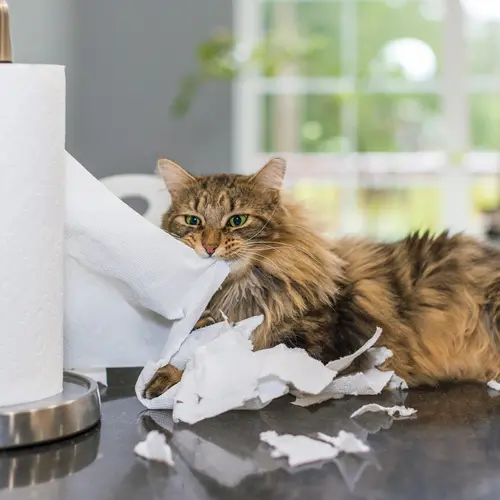Eosinophilic granuloma complex (EGC) refers to different types of inflammation in your cat's skin. It is a "reaction pattern" observed in the cat's skin, caused by several factors.
Several underlying health conditions can cause eosinophilic granuloma complex in cats. Allergic disorders, such as hypersensitivity, are the major causes of this condition.
EGC encompasses different diseases. All of them are very itchy and may worsen if your cat licks the lesions.
The Classification of Diseases in Eosinophilic Granuloma Complex
The feline eosinophilic granuloma complex consists of three types of diseases, including:
Eosinophilic Ulcer (Indolent Ulcer)
Also called "rodent ulcer," this type of skin ulcer is red and well-defined but not painful or itchy. Lesions appear on the edge of the front part of the cat's upper or lower lip, either on one or both sides.
The presence of the ulcer is visible on the lip, with swelling in the ulcerated region. The eosinophilic ulcer can become enlarged in severe cases.
Eosinophilic Plaque
This can be identified as a red, well-defined, raised wound. These lesions can appear in any body part, but they are most commonly seen on the side of the cat's belly.
This type of lesion has flat swelling, with little to no hair on the affected region. The eosinophilic plaque can be extremely itchy and can turn into ulcers.
Eosinophilic Granuloma
These are circular, raised, thickened nodules in yellow to pink color.
They can be red, too. The eosinophilic granuloma can happen anywhere on the body but is most commonly found on the mouth (tongue or palate), footpads, and hind legs.
What Causes Eosinophilic Granuloma Complex in Cats?
Eosinophilic granuloma complex in cats can be caused by insects (particularly fleas) and hereditary factors.
The major allergic reactions can be due to dietary or environmental changes, including antibiotic treatment, heart medications, pollen, and allergy-inducing foods.
How Is Eosinophilic Granuloma Complex Diagnosed?
The EGC lesions are different from other skin diseases in cats. To diagnose these lesions in your cat, the vet examines the pet's tissues through cytology (fine needle aspiration) or biopsy under a microscope. A biopsy can help rule out other issues like tumors, mites, or fungal infections.
The vet may also observe the cat's response to food trials or trial treatments. These may take 6 to 8 weeks but will help limit the unnecessary use of treatments like steroids.
EGC cases caused due to atopy (a reaction to environmental allergens) are more challenging to diagnose.
What Is the Treatment of Eosinophilic Granuloma Complex in Cats?
There is no natural eosinophilic granuloma complex cat treatment. These allergic reactions require medical treatment. Small lesions, though, may resolve on their own if they don't bother the cat.
EGC may also be caused due to a secondary bacterial infection that will require treatment with antibiotics. This treatment shows effective results in improving the lesions, but it will not completely get rid of them.
In other cases, the vet needs to diagnose the severity of the condition and its underlying cause to develop the right treatment plan. If they don't identify any evident cause, or if the cause seems uncontrollable, the vets opt for symptomatic treatment of the lesions.
The most common therapy for EGC in cats is glucocorticoids (steroids). For this therapy, the vet gives the steroids in tablets or liquid form or as an injection. The lesions react very well to the steroids.
The dosage and duration of steroids usually vary from cat to cat. In some cases, vets may suggest recurrent treatment or continuous therapy to manage the condition.
If your vet suspects that your cat needs long-term or high doses of steroids, they may opt for additional therapies to control the steroid dosage and minimize its side effects.
Some other treatments for allergies include:
- Antihistamines in some cases
- Immunosuppressive drugs, like cyclosporin or chlorambucil
- Topical steroids, like hydrocortisone aceponate spray
Some vets also use progestogens (megestrol acetate and medroxyprogesterone acetate) for the treatment. These drugs may be extremely effective for treating lesions, but they pose severe side effects. For this reason, most vets avoid using these drugs for EGC treatment in cats.
If you observe any skin reaction on your cat's body, talk to your vet.

